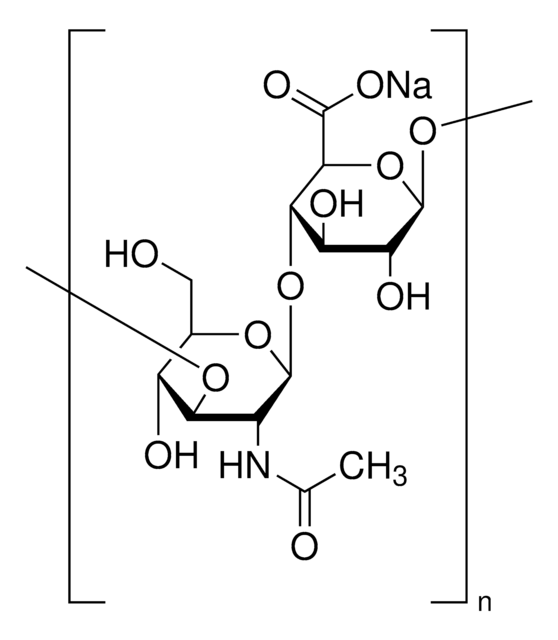53747
Hyaluronic acid sodium salt from Streptococcus equi
bacterial glycosaminoglycan polysaccharide
Sinónimos:
Poly(β-glucuronic acid-[1→3]-β-N-acetylglucosamine-[1→4]), alternating
About This Item
Productos recomendados
biological source
(Streptococcus equi)
Quality Level
form
powder or crystals
mol wt
~1.5-1.8 x 10E6 Da
impurities
≤1% protein
color
white
solubility
H2O: 5 mg/mL, clear, colorless
storage temp.
−20°C
SMILES string
[Na+].CC(=O)N[C@@H]1C[C@H](O)[C@@H](CO)O[C@H]1O[C@H]2[C@H](O)[C@@H](O)[C@H](O)O[C@@H]2C([O-])=O
InChI
1S/C28H44N2O23.Na/c1-5(33)29-9-18(11(35)7(3-31)47-25(9)46)49-28-17(41)15(39)20(22(53-28)24(44)45)51-26-10(30-6(2)34)19(12(36)8(4-32)48-26)50-27-16(40)13(37)14(38)21(52-27)23(42)43;/h7-22,25-28,31-32,35-41,46H,3-4H2,1-2H3,(H,29,33)(H,30,34)(H,42,43)(H,44,45);/q;+1/t7-,8-,9-,10-,11-,12-,13+,14+,15-,16-,17-,18-,19-,20+,21+,22+,25-,26+,27-,28-;/m1./s1
InChI key
YWIVKILSMZOHHF-QJZPQSOGSA-N
General description
Application
- with methacrylic anhydride for synthesizing cross-linkable methacrylated HA hydrogel (Coll-MeHA)
- in phosphate buffer saline (PBS) to replace the PBS bath to vary the lubricant composition
- in the preparation of lubricant to study its effects on the boundary lubrication of human osteoarthritis (OA) cartilage
Biochem/physiol Actions
Other Notes
Storage Class
11 - Combustible Solids
wgk_germany
WGK 2
flash_point_f
Not applicable
flash_point_c
Not applicable
Certificados de análisis (COA)
Busque Certificados de análisis (COA) introduciendo el número de lote del producto. Los números de lote se encuentran en la etiqueta del producto después de las palabras «Lot» o «Batch»
¿Ya tiene este producto?
Encuentre la documentación para los productos que ha comprado recientemente en la Biblioteca de documentos.
Los clientes también vieron
Artículos
There are five identified glycosaminoglycan chains (see Figure 1): Hyaluronan is not sulfated, but the other glycosaminoglycan chains contain sulfate substituents at various positions of the chain.
Glycosaminoglycans are large linear polysaccharides constructed of repeating disaccharide units.
Nuestro equipo de científicos tiene experiencia en todas las áreas de investigación: Ciencias de la vida, Ciencia de los materiales, Síntesis química, Cromatografía, Analítica y muchas otras.
Póngase en contacto con el Servicio técnico

